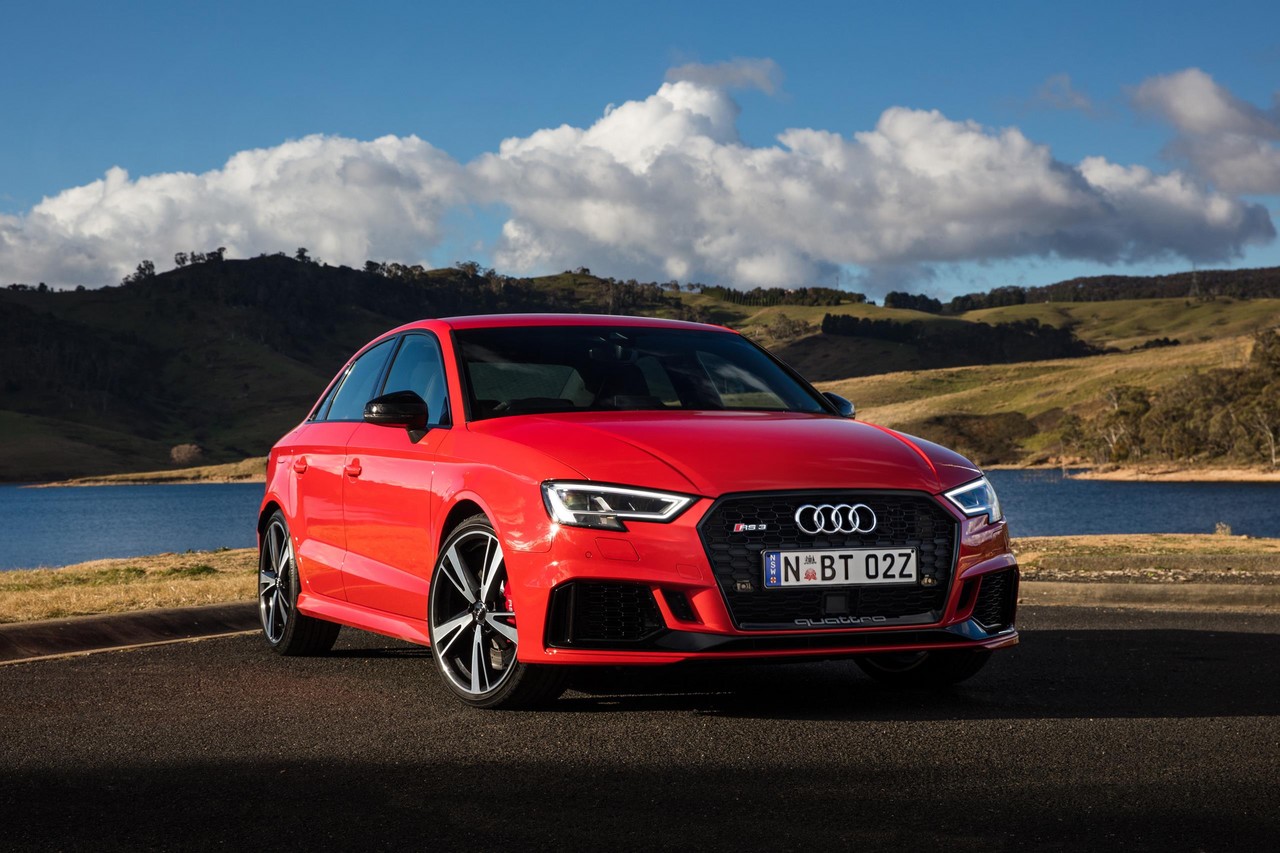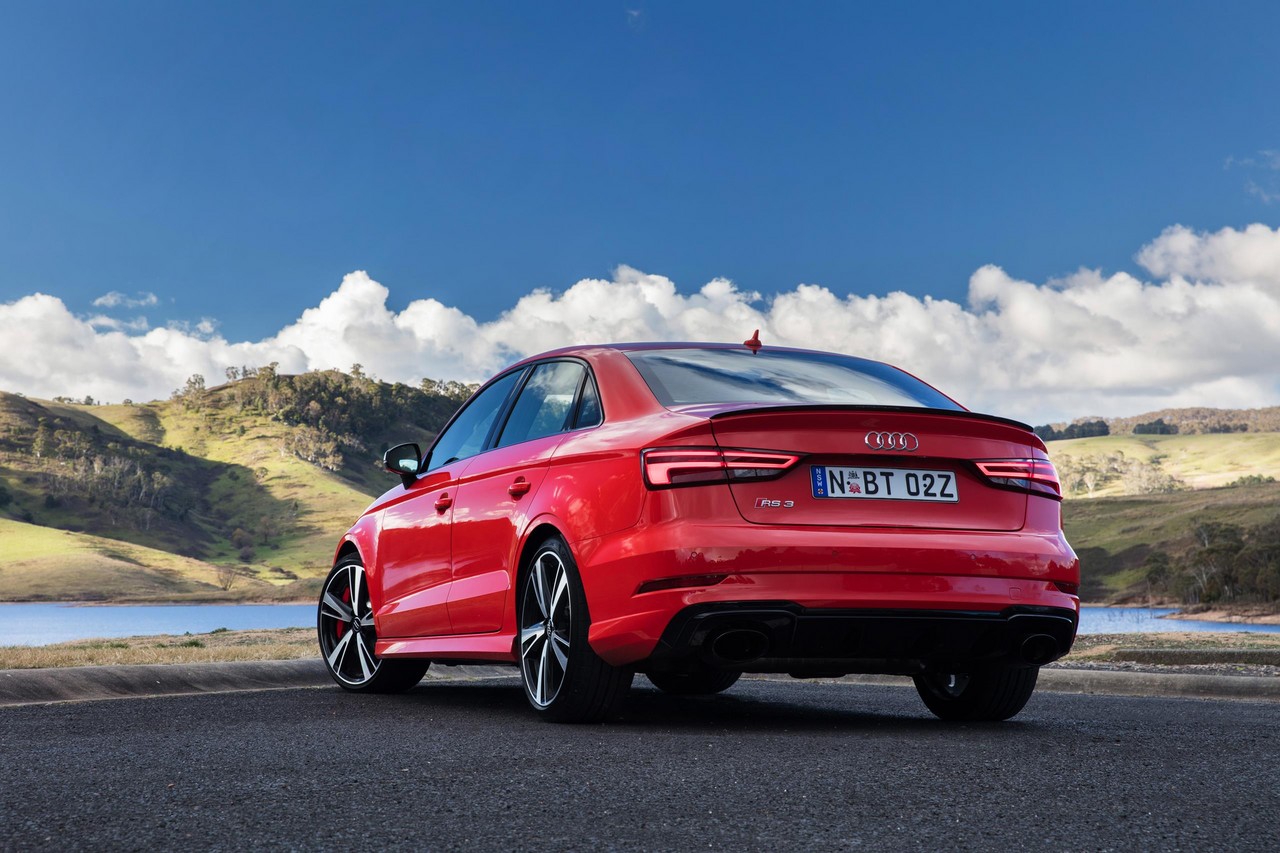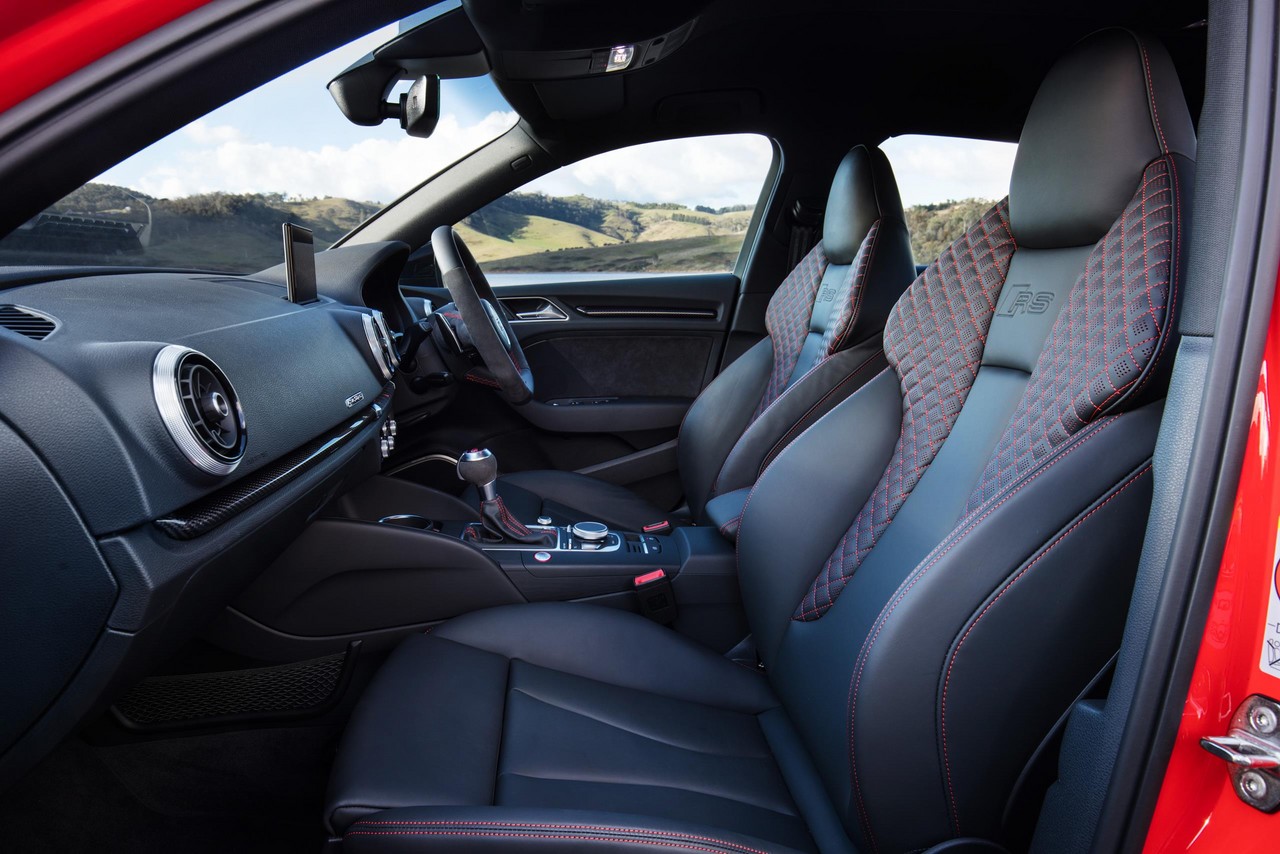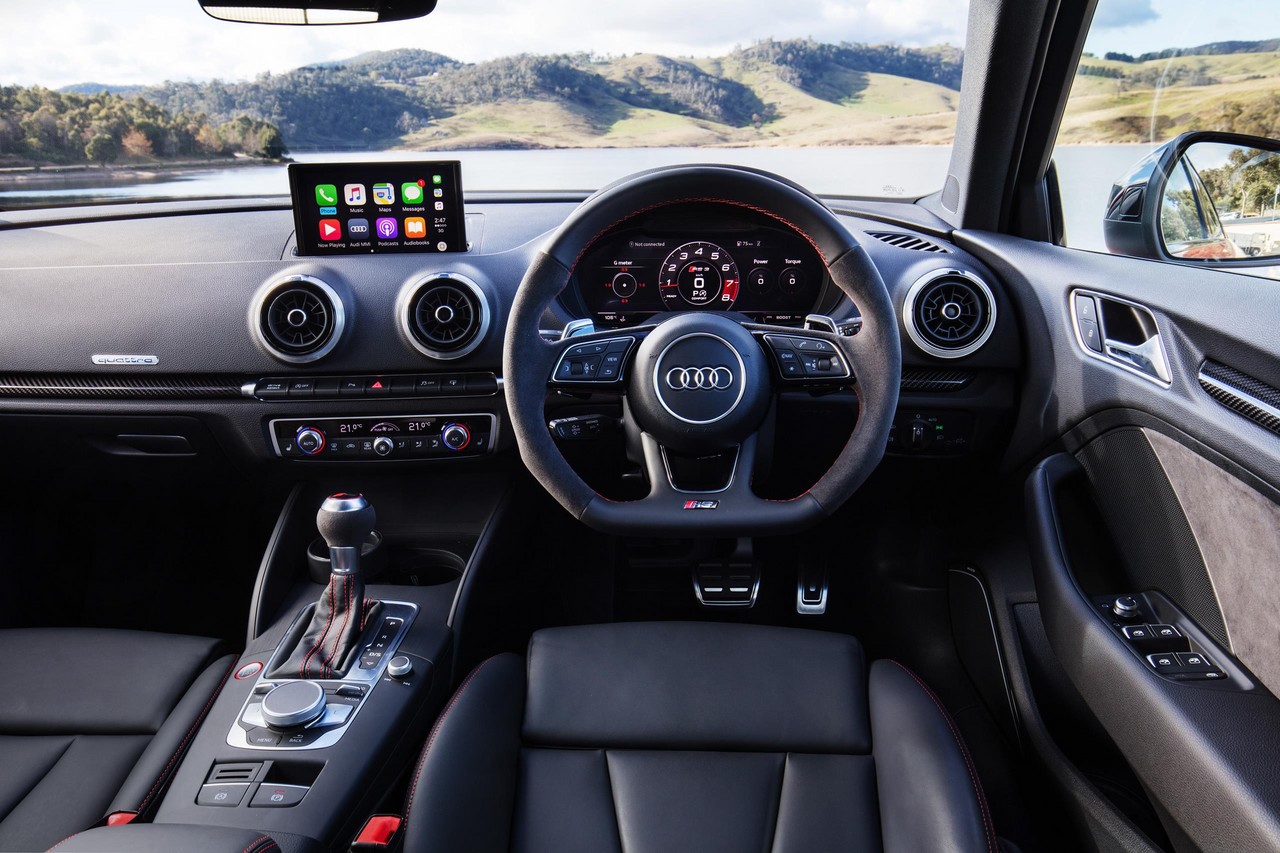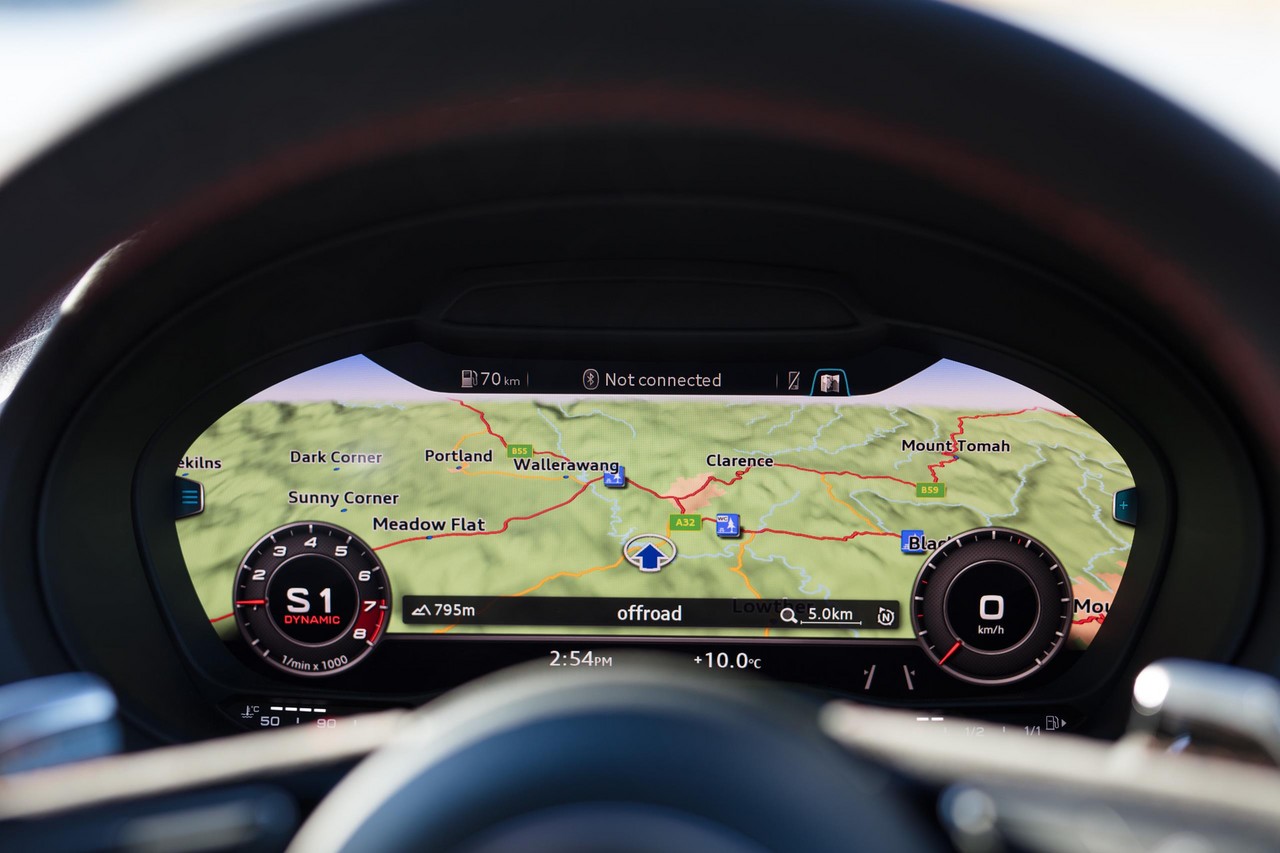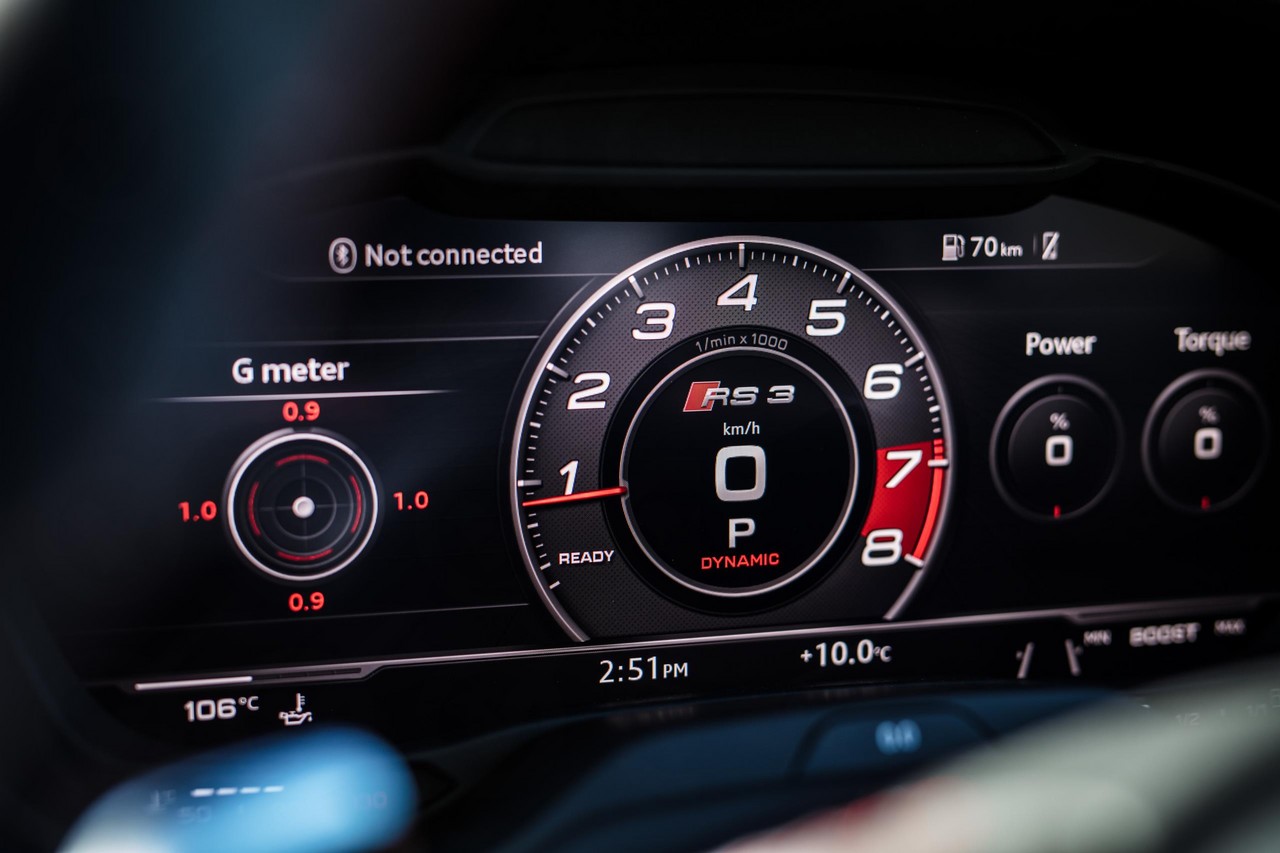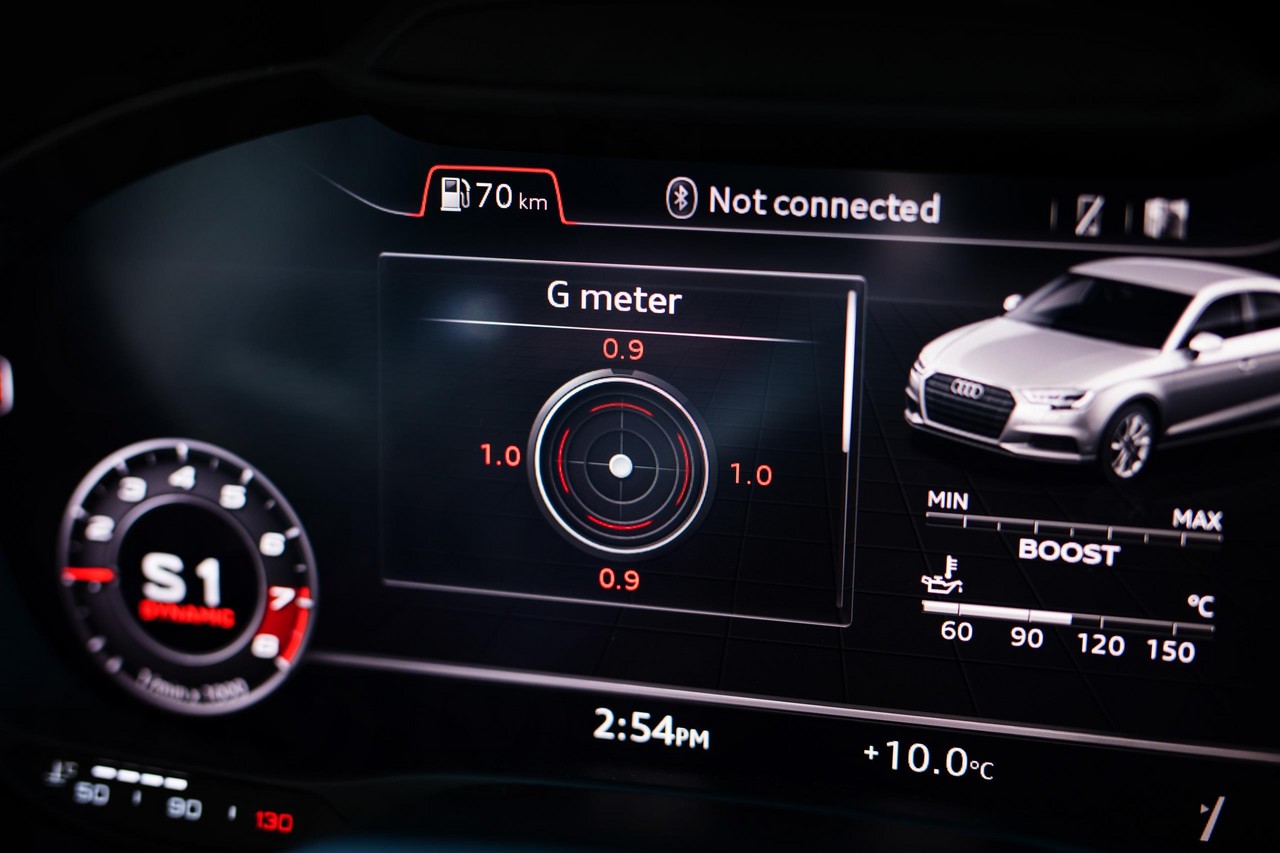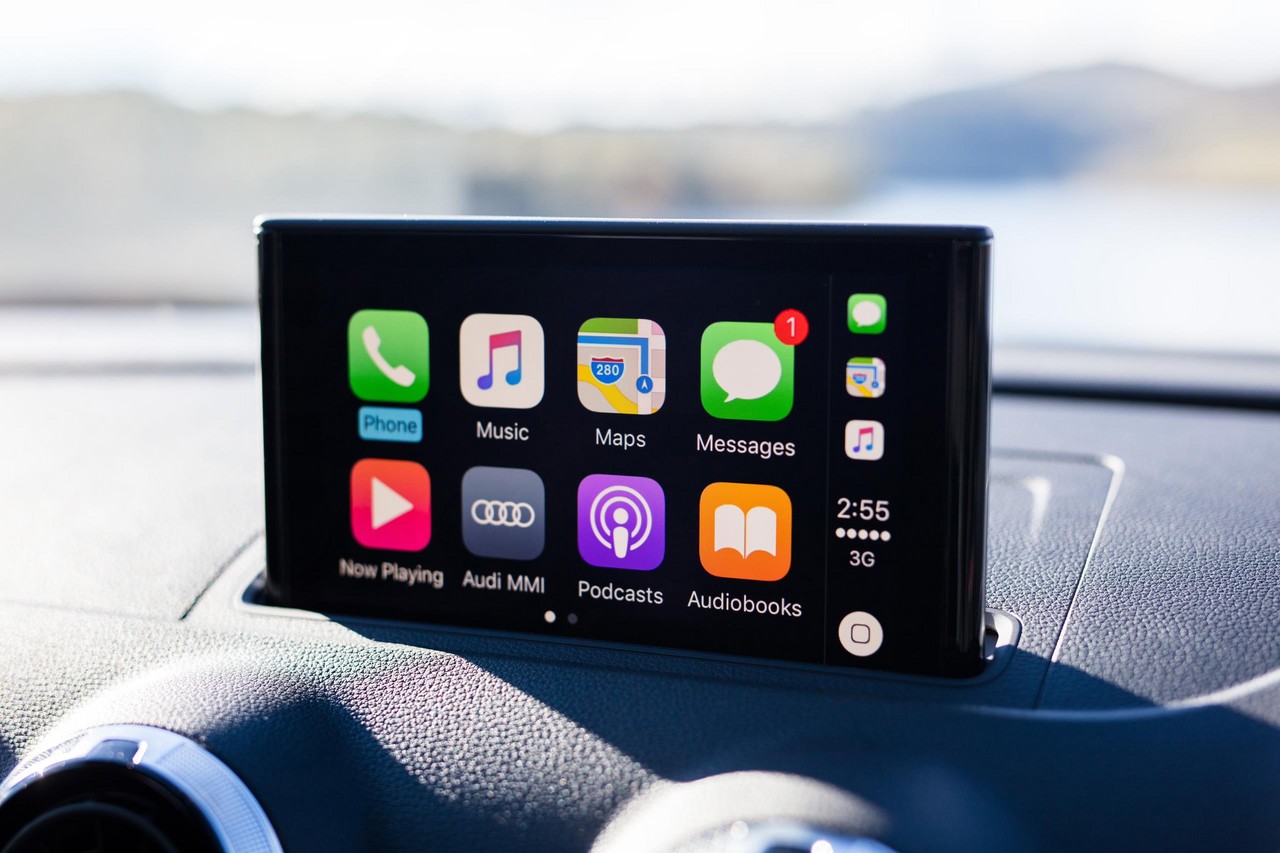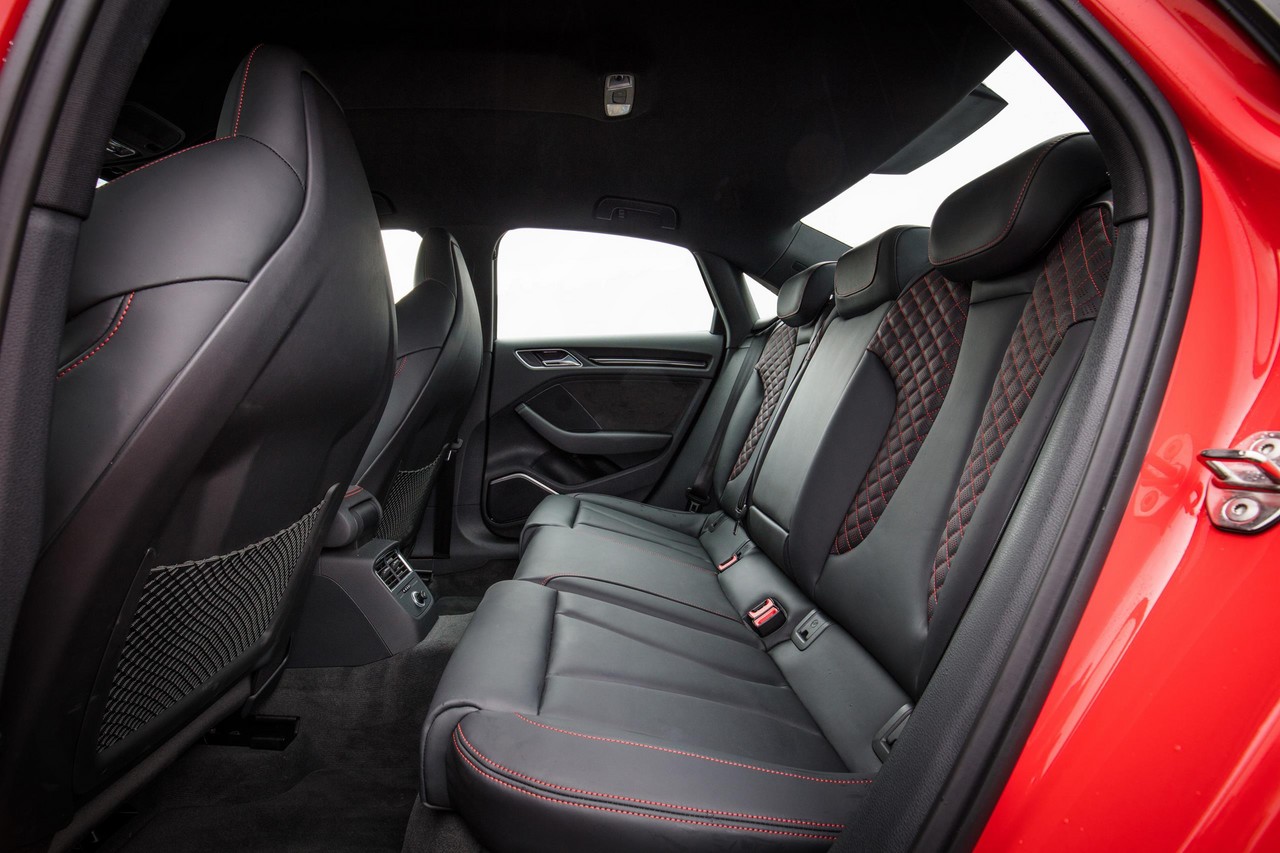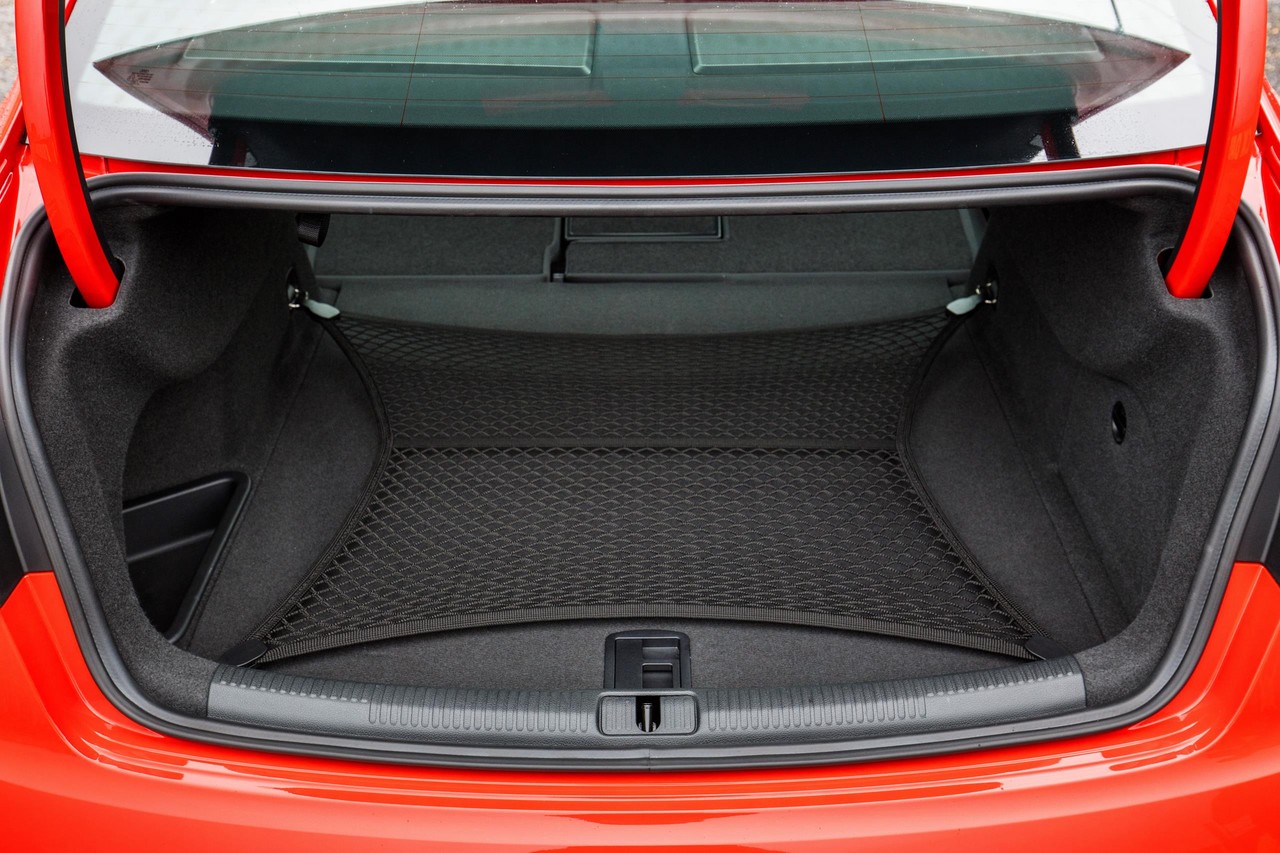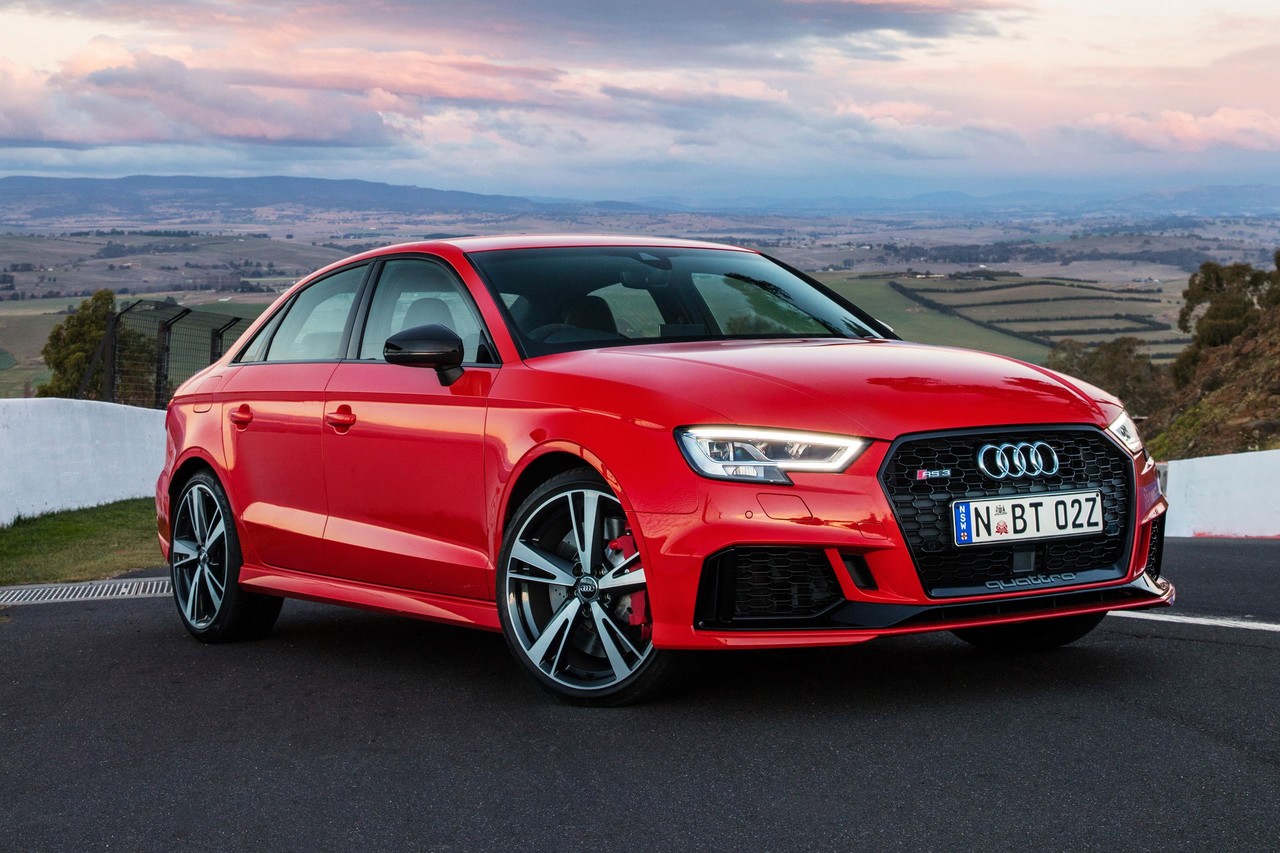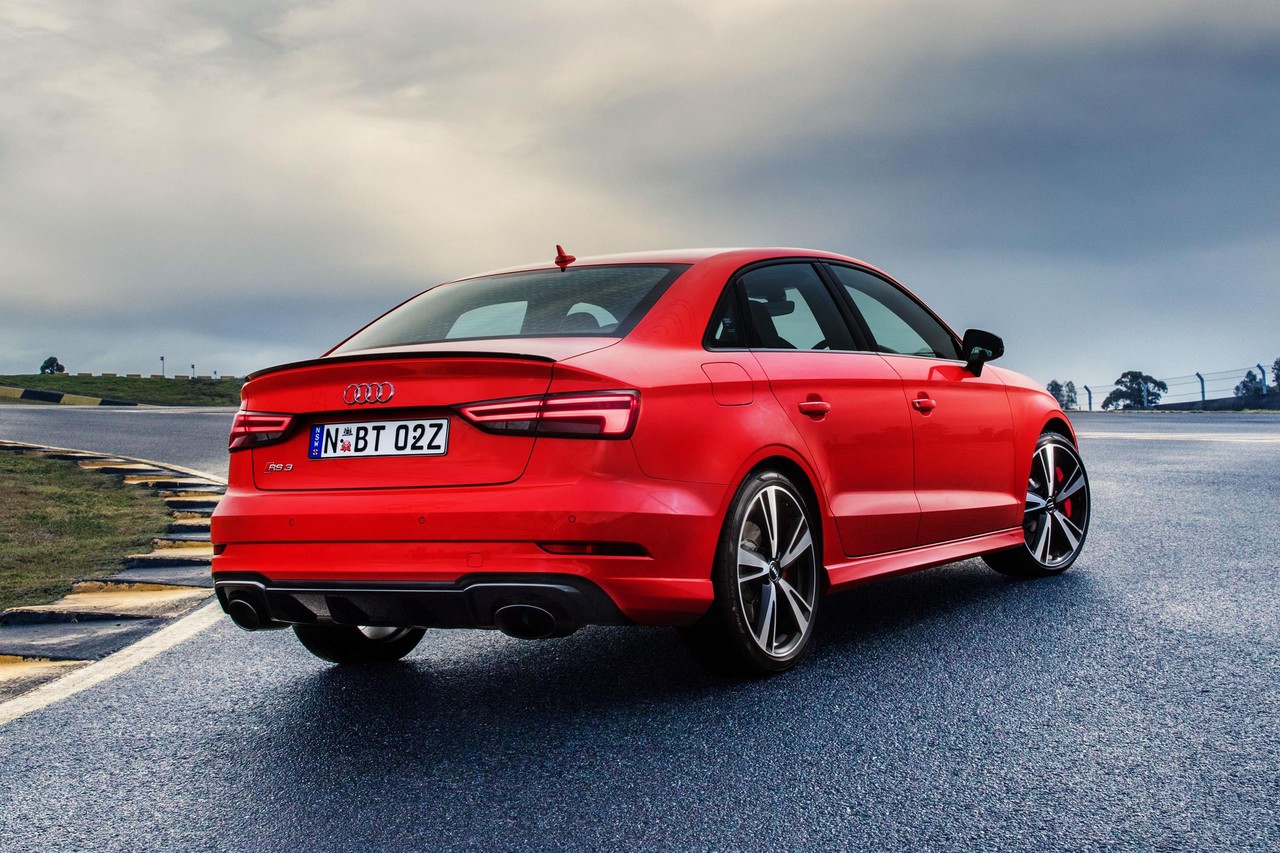
- Characterful and powerful 2.5 R5 TFSI engine
- New all-alloy construction for 2.5 R5 TFSI saves 26 kg and improves weight distribution
- quattro system contributes to excellent dynamics
- S-Tronic transmission provides fast gearshifts
- Stiff suspension
- Tyre roar on coarse surfaces
- Gap in gear ratios from third to fourth
Overview
Released in Australia in June 2017, the Audi 8VS RS 3 was a high-performance, compact sedan. Manufactured in Gyor, Hungary, the all-wheel drive Audi 8VS RS 3 Sedan was powered by a 2.5-litre five-cylinder turbocharged petrol engine that was mated to a seven-speed double clutch transmission (Audi’s ‘S Tronic’). Upon its release, the Audi 8VS RS 3 Sedan had a list price of $84,900 (excluding on-road costs such as dealer delivery, stamp duty, registration and, where applicable, CTP insurance).
Audi 8VS RS 3: DAZA 2.5 TFSI engine
The Audi RS 3 Sedan was powered by a 2480 cc five-cylinder petrol engine (code: DAZA) which had an aluminium alloy crankcase, a die-forged steel crankshaft supported by six main bearings, forged connecting rods, plasma-coated cylinder bores, cast aluminium alloy pistons, a cast aluminium-silicon alloy cylinder head with integrated turbocharger which provided peak boost pressure of 1.35 bar (19.6 psi), chain-driven double overhead camshafts, variable intake and exhaust camshaft timing, four valves per cylinder actuated by roller finger followers and variable exhaust valve lift (the ‘Audi valvelift system’ or AVS). Furthermore, the DAZA engine had both port injection and direct injection that were controlled by the Bosch Motronic MED 17.1.62 engine management system. The 2.5 TFSI engine had a firing interval of 144 degrees and a 1-2-4-5-3 ignition sequence.
Whereas the related Audi 8VA RS 3 Sportback was initially powered by Audi’s CZGB engine which had a compacted graphite iron (CGI) cylinder block, the 2.5 TFSI DAZA engine for the post-2017 Audi RS 3 Sedan and Sportback had a light-alloy crankcase that was 26 kg lighter.
The Audi 8VS RS 3 was the first ‘RS’ sedan to have a transversely mounted engine and could accelerate from rest to 100 km/h in 4.1 seconds. Over the combined ADR 81/02 test cycle, fuel consumption for the Audi RS 3 Sedan was 8.4 litres per 100 km.
| Engine | Trans. | Peak power | Peak torque |
|---|---|---|---|
| 2480 cc DAZA turbo petrol I5 | 7sp DCT | 294 kW at 5850-7000 rpm | 480 Nm at 1700-5850 rpm |
Haldex 5 AWD system (‘quattro’)
The Audi 8VS RS 3 Sedan had a fifth-generation Haldex all-wheel drive system which consisted of an electronically controlled and hydraulically actuated multi-plate clutch that is located in front of the rear axle differential (at the end of the prop shaft). If there was a loss of traction, or such a loss was anticipated by on-board sensors, an electrically driven pump would press the clutch plates together with a maximum oil pressure of 40 bar to transfer up to 50 per cent of the engine’s torque to the rear axle (i.e. a 50:50 torque split). While Audi claimed that ‘[d]ending on the driving style and coefficient of friction, between 50 and 100 percent of the available drive force can be sent to the rear axle’, the latter scenario appears to assume that the front wheels have no traction (so only the rear wheels have any ‘drive force’).
AustralianCar.Reviews also understands that the rear axle is decoupled under low loads or when coasting to reduce fuel consumption.
Body and dimensions
Compared to the related Audi 8VS A3 Sedan , the 8VS RS 3 Sedan was 23 mm longer (at 4479 mm), 6 mm wider (1802 mm), 17 mm lower (1399 mm) and has a 6 mm shorter wheelbase (2631 mm). Furthermore, the RS 3 Sedan had a drag co-efficient of 0.332 Cd and an unladen weight of 1515 kg (excluding driver).
The Audi RS 3 Sedan had a luggage capacity of 315 litres, though this increased to 770 when the rear seats were folded.
Suspension
The Audi 8VS RS 3 Sedan had MacPherson strut front suspension with steel lower wishbones, aluminium pivot bearings and a tubular anti-roll bar. Beyond this, the RS 3 Sedan had four-link rear suspension with sword-shaped trailing links for propulsion and braking forces, and three wishbones per wheel for lateral forces.
As part of the ‘RS performance package’ the Audi RS 3 was available with magneto-rheological fluid-filled dampers which could vary their resistance through the application of an electric current that increases the viscosity of the fluid.
Steering
The Audi 8VS RS 3 Sedan had rack-and-pinion steering with electric power assistance. Like the Audi 8VA RS 3 Sportback , it is understood that the RS 3 Sedan had variable, progressive steering ratios that ranged from 10.9:1 to 15.3:1. Furthermore, the Audi RS 3 Sedan had a turning circle of 11.0 metres.
Safety equipment
Standard safety equipment for the Audi RS 3 Sedan included dual front airbags, a driver’s knee airbag, front side airbags, full-length curtain airbags (i.e. for front and rear occupants), ABS, electronic brake force distribution, brake assist, electronic stability control, traction control and front seatbelts with pre-tensioners and load limiters.
Beyond this, the Audi RS 3 Sedan was also fitted with the following safety technologies as standard –
- Audi pre-sense front: scanned the road for vehicles when travelling at speeds up to 200 km/h and for pedestrians when travelling at speeds of up to 65 km/h. If there was a risk of collision, the driver would be warned and partial braking would be initiated automatically. If the collision risk persisted, full braking could be initiated (i.e. autonomous emergency braking or AEB);
- Adaptive Cruise Control (ACC): using two front radar sensors and the camera, ACC could maintain a specified distance – from five distances – between the A3 Cabriolet and the vehicle ahead. Furthermore, ‘Audi drive select’ could be used to adjust the rate of acceleration and other control dynamics;
- Stop&Go function: an extension of Adaptive Cruise Control, ‘Stop&Go’ operated at speeds of 60 km/h to apply the brakes and bring the vehicle to rest. Once traffic began moving, the Audi RS 3 would automatically accelerate;
- Traffic-jam assist: an extension of the ACC, traffic-jam assist function could take control of steering operations at speeds up to 65 km/h on ‘well-developed roads when traffic is congested.’ In doing so, traffic-jam assist used the lane markings and other vehicles on the road for orientation. When the traffic-jam assist function reached its limits – for example, when traffic is sparse or there is a sharp corner ahead – the driver had to take over steering. Hence, the system provided warnings at different levels;
- Audi active lane assist: operating at speeds of 65 km/h and above, Audi active lane assist used the front camera to recognise lane markings. As the vehicle approached a lane marking without the turn signal having been activated, the system provided a slight steering intervention to direct the vehicle back into its lane. Through the MMI system, the driver could select whether this intervention occurred at an early stage (in which case the vehicle was steered to the centre of its lane) or only shortly before crossing the line. The steering wheel could also vibrate as a warning signal if selected;
- Audi side assist: operating at speeds above 15 km/h, Audi side assist used the two rear radar sensors to monitor traffic up to 70 metres behind the Audi RS 3. If another vehicle approached quickly or was in the driver’s blind spot, a warning LED in the housing of the appropriate door mirror would illuminate. If the driver activated the indicator to change lanes, the LED would blink rapidly to warn the driver;
- Cross traffic assist rear: when reversing at low speeds, rear cross-traffic assist used the rear radar sensors to detect approaching traffic. If approaching traffic was detected which may cross the vehicle’s path, the driver received warnings (visual, acoustic and a brief, jolting application of the brakes);
- Audi pre sense basic: in the event that a collision was anticipated, pre sense basic initiated occupant protection measures such as electric tensioning of the seatbelts and closing of the windows and sunroof (where fitted);
- Attention assist: monitored driver behaviour for signs of inattentiveness and would provide a warning tone and visual signal if detected; and,
- Hold assist: would automatically apply the brakes when the vehicle was stationary to prevent it from rolling as the driver moved their foot from the brake to the accelerator.
Wheels, tyres and brakes
The Audi 8VS RS 3 Sedan had 8.0J x 19-inch front and 8.5J x 19-inch rear alloy wheels with 235/35 R19 tyres; rather than a spare wheel, the RS 3 Sedan had a tyre repair kit. Beyond this, the RS 3 Sedan had 370 mm by 34 mm ventilated front brake discs with eight-piston callipers and 310 mm by 22 mm rear ventilated rear discs with floating brake callipers. As a $9500 extra-cost option, the RS 3 Sedan could be specified with carbon-fibre ceramic front brake discs.
Features: Audi RS 3 Sedan
As standard, the 8VS RS 3 Sedan was equipped with Audi’s ‘MMI navigation plus’ which featured a seven-inch high resolution colour display, live traffic updates and integrated voice control. Since the RS 3 Sedan was fitted with the ‘Audi virtual cockpit’ (i.e. a 12.3-inch high resolution colour display in place of conventional instruments), navigation maps could also be shown in the instrument cluster. Furthermore, the RS 3 Sedan was equipped with ‘Audi connect’ (in-car Wi-Fi hotspot and access to Google services) and the ‘Audi smartphone interface’ for Apple/Android smartphone integration via USB connection.
Beyond this, standard features for the Audi RS 3 Sedan included a ten speaker sound system (including centre speaker and subwoofer) with a six-channel amplifier for an output of 180 watts , a digital radio tuner (DAB+), CD/DVD player, auxiliary input (3.5 mm), two SDXC card readers, 10 GB flash memory, Bluetooth interface with music streaming, fine Nappa leather upholstery with diamond patterned stitching, heated front ‘RS’ sports seats, dual-zone climate control air conditioning, LED headlights and daytime running lights, a flat-bottomed RS multifunction steering wheel with leather and Alcantara trim, remote central locking with proximity key, power adjustable and heated door mirrors with auto-dimming on the driver’s side and a kerb view function for the passenger’s side when reversing, power windows, push-button start, an auto-dimming interior rear view mirror, 12 volt power sockets (in the rear centre console and luggage compartment), aluminium door sill trims with illuminated ‘RS’ logo, titanium grey inlays, tyre pressure monitoring, a trip computer, an alarm and immobiliser.
As standard, the RS 3 Sedan was also fitted with Audi’s ‘parking system plus’ which included ultrasonic sensors (front and rear) and provides automated steering for both perpendicular and parallel parking manoeuvres.
RS performance package
As a $5900 option, the Audi RS 3 Sedan could be specified with an ‘RS performance package’ which included:
- Wider 8.5J x 19-inch front alloy wheels with 255/30 tyres;
- The ‘Audi magnetic ride’ adaptive damper system;
- A Bang & Olufsen Sound System which had a fifteen-channel amplifier for an output of 705 watts and fourteen speakers (including centre speaker and subwoofer); and,
- Carbon inlays.
Paint colours
As standard, the Audi RS 3 Sedan had a Nardo grey paint finish. Beyond this, however, the RS 3 Sedan could be specified in the following extra-cost paint colours –
- Metallic: Catalunya red, Florett silver, Glacier white and Mythos black ($1495);
- Pearl effect: Daytona grey ($1495); and,
- Crystal effect: Ara blue and Panther black ($2015).
Brochure and specifications
- Specification Guide: Audi 8VS RS 3 Sedan (June 2017)
- Technical data: Audi 8VS RS 3 Sedan (June 2017)
